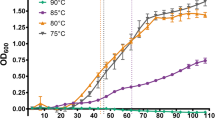Abstract
Different strains of Thiobacillus ferrooxidans were examined for their ability to produce a heat shock and a cold shock response. Strain A1, heat shocked from 20° to 35°C, acquired thermotolerance, as it showed a 1000-fold reduction in cell mortality when exposed to the supermaximum temperature of 42°C, as compared to a non-heat-shocked control. A heat shock from 25° to 35°C yielded similar results, although a higher degree of thermotolerance was achieved for the shorter exposure times. Cultures heat shocked for 5 h showed a five-log reduction in viable counts after 41 h at 42°C, whereas non-heat-shocked cultures showed a similar reduction in viability in 28 h. Conferred thermotolerance was immediate and sustained for the duration of the exposure to 42°C. Heat-shocked cultures were not significantly protected against loss of viability due to freezing (-15°C for 24 h). Strain S2, cold shocked from 25° to 10°C, and strain D6, cold shocked from 25° to 5°C, were not protected against freezing at-15°C. An analysis of proteins extracted from heat-shocked cells of strain A1 showed the presence of at least one newly induced protein and eight hyper-induced proteins. The molecular weights of the heat shock proteins were in the range of 15–80.3 kDa.
Similar content being viewed by others
Literature Cited
Ahonen L, Tuovinen OH (1991) Temperature effects on bacterial leaching of sulfide minerals in shake flask experiments. Appl Environ Microbiol 57: 138–145
Alvarez S, Jerez CA (1989) Molecular aspects of the stress response in Thiobacillus ferrooxidans and other biomining microorganisms. In: Salley J, McCready RGL, Wichlacz PL, (eds) Biohydrometallurgy 1989. Jackson Hole, Wyoming: Canada Centre for Mineral and Energy Technology, pp 439–449
Ang D, Liberek K, Showyra D, Zylicz M, Georopoulos C (1991) Biological role and regulation of the universally conserved heat shock proteins. J Biol Chem 266: 24233–24236
Berthelot D, Leduc LG, Ferroni GD (1993) Temperature studies of iron-oxidizing autotrophs and acidophilic heterotrophs isolated from uranium mines. Can J Microbiol 39: 384–388
Berthelot DB, Leduc LG, Ferroni GD (1994) The absence of psychrophilic Thiobacillus ferrooxidans and acidophilic heterotrophic bacteria in cold, tailings effluents from a uranium mice. Can J Microbiol 40: 60–63
Ferroni GD, Leduc LG, Todd M (1986) Isolation and temperature characterization of psychrotrophic strains of Thiobacillus ferrooxidans from the environment of a uranium mice. J Gen Appl Microbiol 32: 169–175
Herrera L, Ruiz P, Aguillon JC, Fehrmann A (1989) A new spectrophotometric method for the determination of ferrous iron in the presence of ferric iron. J Chem Technol Biotechnol 44: 171–181
Hubert WA, Ferroni GD, Leduc LG (1994) Temperature-dependent survival of isolates of Thiobacillus ferrooxidans. Curr Microbiol 28: 179–183
Jones PG, Van Bogelen RA, Neidhardt F (1987) Induction of proteins in response to low temperature in Escherichia coli. J Bacteriol 169: 2092–2095
Julseth CR, Inniss WE (1990) Heat shock protein induction and the acquisition of thermotolerance in the psychrotrophic yeast Trichosporon pullulans. Curr Microbiol 20: 391–396
Komatsu Y, Kaul SC, Iwahashi H, Obuchi K (1990) Do heat shock proteins provide protection against freezing? FEMS Microbiol Lett 72: 159–162
Laemmli UK (1970) Cleavage of structural proteins during the assembly of the head of bacteriophage T4. Nature 227: 680–685
Leduc LG, Ferroni GD (1994) The chemolithotrophic bacterium Thiobacillus ferrooxidans. FEMS Microbiol Rev 14: 103–120
Leduc LG, Trevors JT, Ferroni GD (1993) Thermal characterization of different isolates of Thiobacillus ferrooxidans. FEMS Microbiol Lett 108: 189–194
Linquist S (1986) The heat-shock response. Annu Rev Biochem 55: 1151–1191
Linquist S, Craig EA (1988) The heat shock proteins. Annu Rev Genet 22: 631–677
Mishra AK, Roy P, Mahapatra SSR (1983) Isolation of Thiobacillus ferrooxidans from various habitats and their growth pattern on solid medium. Curr Microbiol 8: 147–152
Niemelä SI, Sivelä C, Luoma T, Tuovinen OH (1994) Maximum temperature limits for acidophilic mesophilic bacteria in biological leaching systems. Appl Environ Microbiol 60: 3444–3446
Singer PC, Stumm W (1970) Acidic mine drainage: the rate determining step. Science 167: 1121–1123
Tuovinen OH, Kelly DP (1973) Studies on the growth of Thiobacillus ferrooxidans. I. Use of membrane filters and ferrous iron agar to determine viable numbers, and comparison with 14CO2-fixation and iron oxidation as measures of growth. Arch Microbiol 88: 285–298
Varela P, Jerez CA (1992) Identification and characterization of GroEL and DnaK homologues in Thiobacillus ferrooxidans. FEMS Microbiol Lett 98: 149–154
Zeilstra-Ryalls J, Fayet O, Georgopoulos C (1991) The universally-conserved GroE (Hsp60) chaperonins. Annu Rev Microbiol 45: 301–325
Author information
Authors and Affiliations
Rights and permissions
About this article
Cite this article
Hubert, W.A., Leduc, L.G. & Ferroni, G.D. Heat and cold shock responses in different strains of Thiobacillus ferrooxidans . Current Microbiology 31, 10–14 (1995). https://doi.org/10.1007/BF00294626
Issue Date:
DOI: https://doi.org/10.1007/BF00294626




